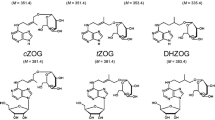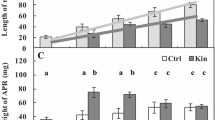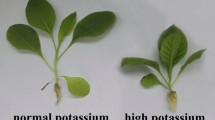Abstract
IT has been reported that electrophoretic protein patterns of hypocotyledonary hooks of bean (Phaseolus vulgaris, L., var. ‘Burpee's Stringless Greenpod’) were altered when the extracted proteins were incubated with the auxin indolyl-3-acetic acid (IAA)1. The alteration consisted of the complete elimination of one protein band. It seemed useful to determine whether this elimination of a protein could occur in vivo in tissue segments treated with IAA.
This is a preview of subscription content, access via your institution
Access options
Subscribe to this journal
Receive 51 print issues and online access
$199.00 per year
only $3.90 per issue
Buy this article
- Purchase on Springer Link
- Instant access to full article PDF
Prices may be subject to local taxes which are calculated during checkout
Similar content being viewed by others
References
Spelsberg, T. C., Esposito, V. M., and Sarkissian, I. V., Plant Physiol. suppl., 40, 61 (1965).
Cleland, R., Handbuch der Pflanzer Physiology (Springer Verlag, Berlin, 754–83 (1961).
Purves, W. K., and Galston, A. W., Amer. J. Bot., 47, 665 (1960).
Ockerse, R., Siegel, B. Z., and Glaston, A. W., Science, 151, 452 (1966).
Siegel, S. M., and Galston, A. W., Proc. U.S. Nat. Acad. Sci., 39, 1111 (1953).
Author information
Authors and Affiliations
Rights and permissions
About this article
Cite this article
SARKISSIAN, I., SPELSBERG, T. Auxin-induced Elimination of a Protein in Bean Hypocotyl. Nature 214, 319–320 (1967). https://doi.org/10.1038/214319b0
Issue Date:
DOI: https://doi.org/10.1038/214319b0
Comments
By submitting a comment you agree to abide by our Terms and Community Guidelines. If you find something abusive or that does not comply with our terms or guidelines please flag it as inappropriate.



